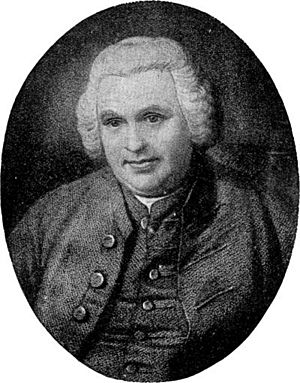Thomas Mudge (horologist) facts for kids
Thomas Mudge (born 1715 – died 14 November 1794) was a very skilled English clock and watch maker. He is famous for inventing the lever escapement. This was a big improvement for pocket watches and is still used in many mechanical watches today.
Contents
Early Life and Training
Thomas Mudge was born in Exeter, England. His father, Zachariah Mudge, was a headmaster and a clergyman. When Thomas was young, his family moved to Bideford. He went to school there.
When he was about 14 or 15, Thomas moved to London. He became an apprentice to George Graham, a famous clock and watch maker. Graham had learned from another great maker, Thomas Tompion. Thomas Mudge learned a lot from Graham.
After finishing his training in 1738, Thomas Mudge started working for important shops in London. He became known for making very complex watches. He even made special watches for Ferdinand VI of Spain, who was a king. One of these watches could tell the time by chiming the hours, quarters, and even minutes!
Starting His Own Business
In 1748, Thomas Mudge opened his own business at 151 Fleet Street in London. After his old teacher George Graham passed away in 1751, Mudge quickly became known as one of England's best watchmakers. In 1753, he married Abigail Hopkins, and they had two sons.
The Lever Escapement
In 1755, Mudge created a very important invention called the detached lever escapement. This special part helps a clock or watch keep accurate time. He first used it in a clock. Later, it was used in pocket watches. This invention was so good that almost every mechanical pocket watch and wristwatch made since then uses a similar design!
In 1765, he wrote a book called Thoughts on the Means of Improving Watches, Particularly those for Use at Sea. This book shared his ideas on making watches better, especially for sailors.
Working on Chronometers
By 1770, Thomas Mudge was not feeling well. He left London and moved to Plymouth to live with his brother. Even though he was not running his business anymore, he kept working on a special type of clock called a marine chronometer. These clocks were very important for sailors to find their exact location at sea.
He wanted to meet the strict rules set by the Board of Longitude. This group offered prizes for accurate ways to find longitude at sea. Mudge sent his first chronometer for testing in 1774. He won 500 guineas (a type of old British money) for his design.
He made two more chronometers in 1779. These were tested by the Astronomer Royal, Nevil Maskelyne. However, they were said to not be good enough. There was a disagreement about whether the tests were fair. Eventually, in 1792, a special group in the government decided that Mudge was right. They gave him £2,500 for his hard work.
Royal Recognition
In 1770, George III, the King of England, bought a large gold watch made by Mudge. This watch had Mudge's special lever escapement inside. The King gave it to his wife, Queen Charlotte. This watch is still kept in the Royal Collection at Windsor Castle today. In 1776, Thomas Mudge was officially named the watchmaker to the King.
Later Life and Death
Thomas Mudge's wife, Abigail, passed away in 1789. Thomas Mudge himself died on 14 November 1794, at his elder son's home in South London. He was buried in a church called St Dunstan-in-the-West in Fleet Street, London.


